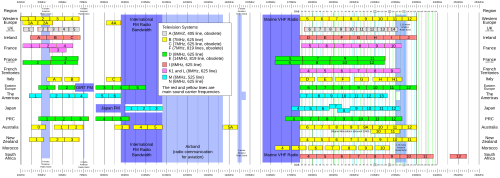Bob
Have a question related to this hub?
Alice
Got something to say related to this hub?
Share it here.

CCIR System K is an analog broadcast television system used in countries that adopted CCIR System D on VHF, and in Benin, Guinea, Republic of the Congo, Togo, Senegal, Burkina Faso, Burundi, Ivory Coast, Gabon, Comoros, Democratic Republic of the Congo, Madagascar, Mali, Nigeria, Réunion, Rwanda, Chad, Central African Republic, French Polynesia, New Caledonia, Wallis and Futuna, Guadeloupe, Martinique, Saint Pierre and Miquelon, and French Guiana.[1]
It is identical System D in most respects.[2][3][1] Used only for UHF frequencies, its paired with SECAM or PAL color systems.
Some of the important specs are listed below:[4][2][5]
Television channels were arranged as follows:[3]
| Channel | Video carrier (MHz) | Audio carrier (MHz) |
|---|---|---|
| 21 | 471.25 | 477.75 |
| 22 | 479.25 | 485.75 |
| 23 | 487.25 | 493.75 |
| 24 | 495.25 | 501.75 |
| 25 | 503.25 | 509.75 |
| 26 | 511.25 | 517.75 |
| 27 | 519.25 | 525.75 |
| 28 | 527.25 | 533.75 |
| 29 | 535.25 | 541.75 |
| 30 | 543.25 | 549.75 |
| 31 | 551.25 | 557.75 |
| 32 | 559.25 | 565.75 |
| 33 | 567.25 | 573.75 |
| 34 | 575.25 | 581.75 |
| 35 | 583.25 | 589.75 |
| 36 | 591.25 | 597.75 |
| 37 | 599.25 | 605.75 |
| 38 | 607.25 | 613.75 |
| 39 | 615.25 | 621.75 |
| 40 | 623.25 | 629.75 |
| 41 | 631.25 | 637.75 |
| 42 | 639.25 | 645.75 |
| 43 | 647.25 | 653.75 |
| 44 | 655.25 | 661.75 |
| 45 | 663.25 | 669.75 |
| 46 | 671.25 | 677.75 |
| 47 | 679.25 | 685.75 |
| 48 | 687.25 | 693.75 |
| 49 | 695.25 | 701.75 |
| 50 | 703.25 | 709.75 |
| 51 | 711.25 | 717.75 |
| 52 | 719.25 | 725.75 |
| 53 | 727.25 | 733.75 |
| 54 | 735.25 | 741.75 |
| 55 | 743.25 | 749.75 |
| 56 | 751.25 | 757.75 |
| 57 | 759.25 | 765.75 |
| 58 | 767.25 | 773.75 |
| 59 | 775.25 | 781.75 |
| 60 | 783.25 | 789.75 |
| 61 | 791.25 | 797.75 |
| 62 | 799.25 | 805.75 |
| 63 | 807.25 | 813.75 |
| 64 | 815.25 | 821.75 |
| 65 | 823.25 | 829.75 |
| 66 | 831.25 | 837.75 |
| 67 | 839.25 | 845.75 |
| 68 | 847.25 | 853.75 |
| 69 | 855.25 | 861.75 |

French overseas departments and territories used a variation named System K1 for broadcast in VHF.[6] UHF channels were similar to K.[3]
| Channel | Video carrier (MHz) | Audio carrier (MHz) |
|---|---|---|
| 2 | 52.25 | 58.75 |
| 3 | 60.25 | 66.75 |
| 4 | 175.25 | 181.75 |
| 5 | 183.25 | 189.75 |
| 6 | 191.25 | 197.75 |
| 7 | 199.25 | 205.75 |
| 8 | 207.25 | 213.75 |
| 9 | 215.25 | 221.75 |
| 10 | 223.25 | 229.75 |